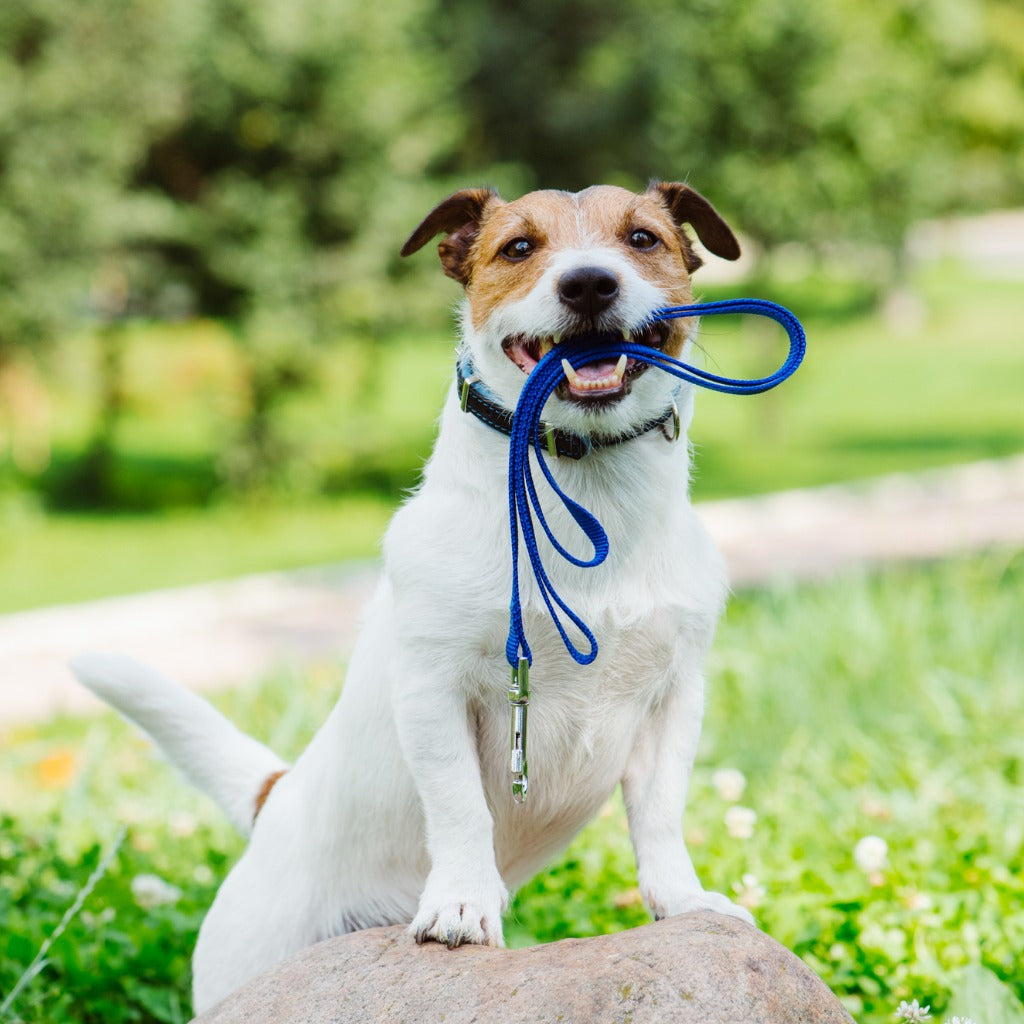How Often Do You Walk Your Dog in 2025?

Walking your dog is more than just a daily routine; it plays a crucial role in maintaining your dog's physical and mental health. This blog post aims to provide a comprehensive guide on creating a tailored dog walking routine, considering the breed, age, and health factors, so your canine companion can thrive. In this guide, we will answer the question, "How often do you walk your dog?" to ensure the best possible routine for your furry friend.
Short Summary
-
Determine a dog's optimal frequency of walks based on their breed, age, and health condition.
-
Regular walking offers numerous physical & mental benefits to both dogs & owners.
-
Utilize positive reinforcement, adjust walk comfort level, monitor health & adhere to safety measures for a successful experience.
Determining the Ideal Frequency for Dog Walks
Establishing the ideal walking frequency for your dog depends on several factors, including their breed, age, and overall health. By understanding these factors and considering how much exercise your dog needs, you can create a walking routine that ensures their well-being and happiness.
This routine should be tailored to your dog's needs, considering their age, breed, and health. For example, a young puppy may need more frequent walks than an older dog, while a large dog may need more frequent walks.
Breed's Impact on Walking Needs
Different dog breeds have diverse exercise needs and restrictions, which should be considered when constructing a schedule for daily dog walks. For example, sheep and cattle dogs require at least four 20-25 minute walks daily and 30 minutes of intelligence game sessions to meet their physical and mental needs. At the same time, younger companion dogs may only need a 30-minute daily walk to maintain their physical and mental well-being.
Dogs, such as Pinschers, Schnauzer, and Greyhounds, need a minimum of 1.5 hours of daily walks and exercise, which can be achieved through regular walks and other activities. It is highly recommended that they receive three walks per day of at least 30 minutes, in addition to cognitive activities and occasional visits to a dog park for socialization.
When planning a dog walk, it is important to consider the dog breed, as working and sporting breeds, such as Shepherds, Pointers, and Collies, generally possess heightened exercise needs compared to lapdogs, including Papillons and Yorkshire Terriers. For instance, Terriers require a minimum of 1.5 hours of activity daily, including 20 minutes of mental activity games, to maintain their physical fitness.
Age and Walking Frequency
A dog's age plays a significant role in determining walking frequency, with puppies requiring shorter, more frequent walks and adult dogs needing longer, more exploratory walks. It is suggested that puppies take a 10-minute walk two or three times a day. Adult dogs' duration and frequency may vary depending on breed and energy level, and it is recommended to start taking your dog on jogs or bike rides when they are comfortable with the gait and distance. It is important to let puppies choose the pace and distance that is comfortable for them.
When determining the frequency of walks for an adult dog, consider their energy level, individual personality, and the owner's schedule. Be mindful of the aspects to remember when walking puppies and older dogs and the possibility of increasing the length and frequency of walks for adult dogs. Older dogs may benefit from shorter and more frequent walks, adjusted to their energy level and potential health issues.
Health and Exercise Considerations
Health and physical limitations should be considered when planning a dog's walking routine, with adjustments made as needed. Canines with health issues such as obesity or diabetes may experience difficulty while walking. If a senior dog cannot complete a walk, consider giving them a ride in a wagon or stroller to give them a break while still exposing them to the enriching experience of the walk.
When walking a senior canine with arthritis, practice slow and frequent movement and consult a veterinarian to be aware of any signs of pain and fatigue, such as limping, stopping, lying down, heavy panting, or difficulty getting on or off curbs. Atrophy, arthritis, diabetes, and hypothyroidism are some medical conditions that may impact a dog's walking stamina.
To protect their feet, consider using dog booties or paw protectors during walks if your dog's feet are prone to cracking or damage. For larger canines with mobility issues, utilize a harness to assist them during walks.
The Benefits of Regular Dog Walks
Regular dog walks provide numerous physical and mental health benefits for dogs and their owners. Walking is essential for maintaining muscle tone and an appropriate weight according to a dog's age and breed, providing mental stimulation, aiding in developing confidence, and reducing the risk of anxiety and aggression.
In addition to the physical benefits, regular dog walks can help reduce behavioral issues such as anxiety and aggression. They also promote weight control, joint health, and overall well-being for you and your dog. By employing positive reinforcement during dog walks, you can create a successful and enjoyable experience for you and your four-legged friend.
Recognizing Signs of Over- or Under-Walking
Recognizing signs of over- or under-walking can help prevent injuries and ensure your dog gets the appropriate amount of exercise. Signs of over-walking may include muscular fatigue, hyperthermia, articulation trauma, behavioral fluctuations, and damage to paw pads. On the other hand, signs of under-walking may include weight gain, agitation, and destructive behavior.
By being aware of these signs, you can adjust your dog's walking schedule accordingly to provide the optimal amount of exercise for their needs. This will ensure their overall health and well-being and prevent potential injuries and health issues caused by over- or under-walking.
Essential Dog Walking Tips
When it comes to dog walking, there are some essential tips to keep in mind for a successful experience. Positive reinforcement during walks increases the likelihood of success and helps develop a strong bond between you and your dog. Adjusting the walk to your dog's comfort level is crucial, considering their confidence level and avoiding overwhelming them with people or other dogs.
Moreover, consider your dog's joints and overall health, age, breed, and existing health conditions. It is essential to adjust the intensity and duration of the walk accordingly to provide the right amount of exercise for your dog, especially when dealing with younger dogs.
Also, be mindful of safety measures such as avoiding walks during the hottest part of the day, using appropriate equipment, and staying hydrated.
Alternative Exercises for High Energy Dog Breeds
For high-energy dog breeds, alternative exercises can be a great way to keep them mentally and physically engaged, especially if regular walks are insufficient to meet their exercise needs. Agility training, which involves a dog navigating an obstacle course, is an excellent way to ensure your dog is physically and mentally stimulated.
Other alternative exercises may include scent work, interactive games, and treat puzzle toys, all of which can help maintain your dog's physical fitness and mental well-being. Be creative and experiment with various activities to ensure your high-energy dog receives the exercise they need while keeping the experience positive and enjoyable.
Adapting Your Walking Routine for Older Dogs
As your dog ages, its physical needs may change, and it's essential to adapt your walking routine accordingly. Older dogs may benefit from shorter and more frequent walks, adjusted to their energy level and potential health issues. So, how often should you walk your older dog? Walking is a low-impact exercise that supports overall health and assists dogs in sustaining their strength.
Modifications to a walking routine for an elderly canine may include short walks that are more gentle and on softer surfaces to meet their changing physical needs. By adapting your walking routine, you can ensure your senior dog continues enjoying exercise while accommodating their evolving needs.
Best Time of Day for Dog Walks
The best time of day for dog walks can vary depending on age, breed, and weather. Generally, taking a dog for a walk in the morning or early evening before 8 pm is most beneficial. This helps avoid the intense heat of the midday sun, which can harm your dog.
Age, breed, and weather can all impact determining the best time of day for dog walks. It is also important to wait at least two hours after a meal before walking to ensure your dog's food has been properly digested.
Considering these factors, you can choose the most suitable time for your dog's walk, ensuring its comfort and well-being.
Dealing with Potty Breaks and Accidents
Handling potty breaks and accidents during walks involves patience, consistency, and positive reinforcement to help your dog develop good habits. Adult dogs typically need potty breaks every 6-8 hours, while puppies may need more frequent breaks depending on their age, and senior dogs every 4-6 hours. Walks are essential for apartment dogs who do not have access to a yard and rely on walks for bathroom breaks.
Should your dog have an accident during a walk, it is important to remain composed and not reprimand them. Clean up the mess and return home, using the experience to reinforce good potty habits by offering praise and treats when your dog goes to the bathroom in the designated area.
When You Can't Walk Your Dog: Alternatives and Hiring a Dog Walker
If you cannot walk your dog, consider alternative exercises or hire a professional dog walker to meet their exercise needs. Alternatives may include playing fetch, tug-of-war, mental enrichment games, hydrotherapy, treadmill workouts, or playdates with a friend. These activities can help maintain your dog's physical and mental well-being when you cannot walk them.
Should you need assistance with walking your dog regularly, seek help from a friend or a professional dog walker. This will ensure your dog receives the necessary exercise and mental stimulation, even when you're unable to walk them yourself.
Summary
In conclusion, creating a personalized dog walking routine is essential for maintaining your dog's physical and mental health. By considering factors such as breed, age, and health and applying essential walking tips, you can ensure your furry friend receives the appropriate amount of exercise. So grab your dog's collar, lace up your shoes, and embark on a walking journey to benefit you and your four-legged companion.
Frequently Asked Questions
How many walks a day does a dog need?
It is generally agreed that dogs should be taken on walks at least three times per day, ideally up to 4 times per day, for a duration of 15 minutes for each walk.
This is important for their physical and mental health, allowing them to explore and exercise. It also helps to reduce boredom and destructive behavior. It can also help strengthen the bond between the dog and its owner.
How often does the average person walk their dog?
On average, the recommended amount of walking for a dog is twice daily for at least 20 minutes each time. This means most pet owners will walk their dogs around 1 mile per day, 7 miles per week, and 364 miles a year!
Is it OK not to walk your dog every day?
Although exercising a dog daily is ideal, there are circumstances where it may not be possible or necessary. Every pet parent should take the time to assess their situation and consult their veterinarian to determine what is best for their pup.
Ultimately, doing whatever is necessary to ensure your dog remains healthy and happy is important.
Is a 20-minute walk enough for a dog?
Yes, a 20-minute walk is enough for a dog, provided they have relatively good physical health.
However, dogs that are overweight or have health issues may be unable to manage a full 20 minutes and may need a shorter walk instead.
How often should I walk my dog?
Generally speaking, you should walk your dog twice a day for around 20 minutes at a time. Consider also providing regular playtime and shorter walks to ensure your pup gets enough exercise.
Subscribe
Sign up to get the latest on sales, new releases and more…
Categories
- Tails of Celebration: Día de los Muertos / Day of the Dead for Pets, A Festival of Memory in Mexico
- How to Care for Senior Dogs in Fall: Mobility Tips & Joint Support
- Tails of Celebration: Kukur Tihar & The Tihar Festival of Nepal
- What is a VDI Testing for dogs ? : Insights, Procedures and Preventive Measures
- Cheap Dog Beds vs. Luxury Dog Beds: The Real Cost of a $50 "Disposable" Dog Bed
- Can Dogs Have OCD? Understanding Canine Compulsive Behaviors (CCD)
- Does My Dog Like Music? Find Out What Tunes Make Your Pup Wag!
- Effective Solutions for Food Aggression in Dogs
- 7 Frozen Treats Your Dog Will Love This Summer☀️🧊🍉
- The Best Waterproof Liners for Dog Beds: Protect Against Spills, Drool, and Accidents
- How to Cope with the Loss of a Dog: A Tribute to Every Companion We Carry in Our Hearts
- Top Tips on How to Prevent Matting in Dogs
- Understanding and Managing Dogs with Hip Dysplasia
- The Ultimate Guide to Dog Gut Health: Natural Remedies, Probiotic Insights and Signs of Poor Gut Health
- The Best Supplements for Dogs: Explore Top Picks for Canine Health and Wellness
- How Often Should I Brush My Dog's Teeth? Tips for Optimal Canine Dental Health
- Ultimate Guide on How to Comfort Your Dog During Fireworks this 4th of July
- Managing a Blowing Coat: Essential Grooming Tips for Double-Coated Dogs.
- 5 Daily Habits That Boost Your Dog’s Long-Term Wellness
- Mastering Crate Training a Dog: Tips and Benefits
- Dog Car Seats vs. Seat Covers: What’s The Best Option For Your Companion?
- Best Outdoor Dog Beds: Luxury, Durability, and Unmatched Comfort
- Is My Dog Overweight? Tips to Assess and Help Your Companion
- The Best Faux Fur Dog Beds for Ultimate Pet Comfort of 2025
- Dog Running Guide: How to Start, Train & Stay Safe when running with your Dog
- Indestructible Dog Beds? The Truth Behind the Term
- Top Tips for Effective Exercise for Dogs
- Effective Dog Ear Cleaning: A Step-by-Step Guide for Maintaining Healthy Ears
- How to Manage Dog Aggressive Behaviors: Expert Tips and Advice
- Effective Canine Ear Infection Remedies: Symptoms, Causes & Treatments
- How to Make a New Dog Comfortable in Their New Home - 2025 Guide
- Signs of Dog Allergy Symptoms and How to Help and Prevent Them
- Why Does My Dog Lick Their Paws? Causes and Solutions Explained
- Dog Alzheimer's: Symptoms, Causes, and Treatment Options
- The Legacy of Comfort with the Iconic Animals Matter® Ortho Companion-Pedic® Puff Luxury Dog Bed
- Orthopedic Square Dog Beds: The Ultimate Blend of Luxury, Comfort, and Support
- Loungers: The Ultimate Beds for Luxury, Comfort, and Orthopedic Support
- Square Dog Beds: Orthopedic Comfort and Stylish Designs for Your Companion
- Effective Solutions for Canine Incontinence: Identifying Causes and Best Treatments
- Ethical, Sustainable, and Certified: Why Certified Products Matter, Exploring CA Prop 65 and CertiPUR-US® Standards
- Dog Seizures: Signs, Causes, and How to Help Dogs with Seizures
- Celebrate National Dog Day: Here are ideas for Dog Lovers and a dive into the history of our canine companions.
- Top Memory Foam Dog Beds for Comfort and Support
- The Best Beds for Arthritic Dogs: Comfort and Support for Your Furry Companion
- 8 Best Tips for a Comforting Dog
- Cozy Comfort for Pets: The Best Puff Dog Bed
- Ultimate Comfort Outdoors: Choosing the Best Outdoor Dog Bed for Your Pet
- Best Back Seat Extender for Dogs: 2025 Top Choices Reviewed for Travel
- Ultimate Comfort: Find the Best Dog Bed Bolster for Your Companion's Rest
- Top 5 Cozy Dog Christmas Bed Picks for a Holly Jolly Pup











Leave a comment
Please note, comments must be approved before they are published